15 Sales Automation Workflows to Close More Deals
Summarize this article with:

Sales teams in most organizations constantly juggle multiple tasks, from prospecting and qualifying leads to closing deals. The sheer amount of work can lead to burnout and missed opportunities. To address this issue, organizations have turned to artificial intelligence (AI) and workflow automation technologies.
According to Hubspot, 57% of sales professionals agree that most sales reps will incorporate AI and automation into their roles by 2024. This reflects a growing trend of leveraging technology to improve how departments across organizations operate. This article will provide an overview of fifteen workflow automation in sales that you can implement to enhance your productivity.
What Is Sales Workflow Automation?
Sales workflow automation involves streamlining and optimizing repetitive sales processes. You can trigger actions like sending emails, scheduling meetings, and assigning tasks using automation software programmed with predefined rules and conditions, limiting manual intervention.
With automated sales workflows, you can quickly launch algorithms and execute routine tasks at a reduced risk of errors. This saves time and effort, allowing your sales representatives to focus on more strategic activities while ensuring increased operational efficiency.
Benefits of Workflow Automation in Sales
Sales workflow automation enables your sales teams to focus on building relationships and closing deals. It offers several advantages to help your organization maximize revenue and improve sales performance. Some of them include:

Increased Efficiency
By automating tasks like data entry, invoice creation, and lead assignment, your sales team can significantly reduce the time spent on administrative duties. This allows them to focus more on high-level strategic activities that drive revenue, such as prospecting, qualifying leads, and closing deals.
Improved Lead Quality
Automation tools can help you segment and nurture leads based on specific criteria, ensuring your sales teams engage with more qualified prospects. This targeted approach maximizes the likelihood of converting potential leads into paying users, improving the overall quality of the sales pipeline.
Enhanced Customer Experience
Automated follow-ups, personalized communications, and timely responses to inquiries can significantly enhance your customers’ experience. This can increase their satisfaction and loyalty toward your brand, leading to repeat business and a growing user base through word of mouth.
Better Data Management
Sales workflow automation empowers your teams to organize and analyze sales data more effortlessly. It allows you to track performance, identify trends or patterns for informed decision-making, and refine sales strategies for better outcomes. With support for advanced analytics, you can also perform sales forecasting.
15 Examples of Sales Workflow Automation
By automating mundane tasks, your sales team can prioritize cultivating stronger customer relationships. This will result in a growing number of brand advocates who enhance your organization's reputation as trustworthy and consumer-centric.
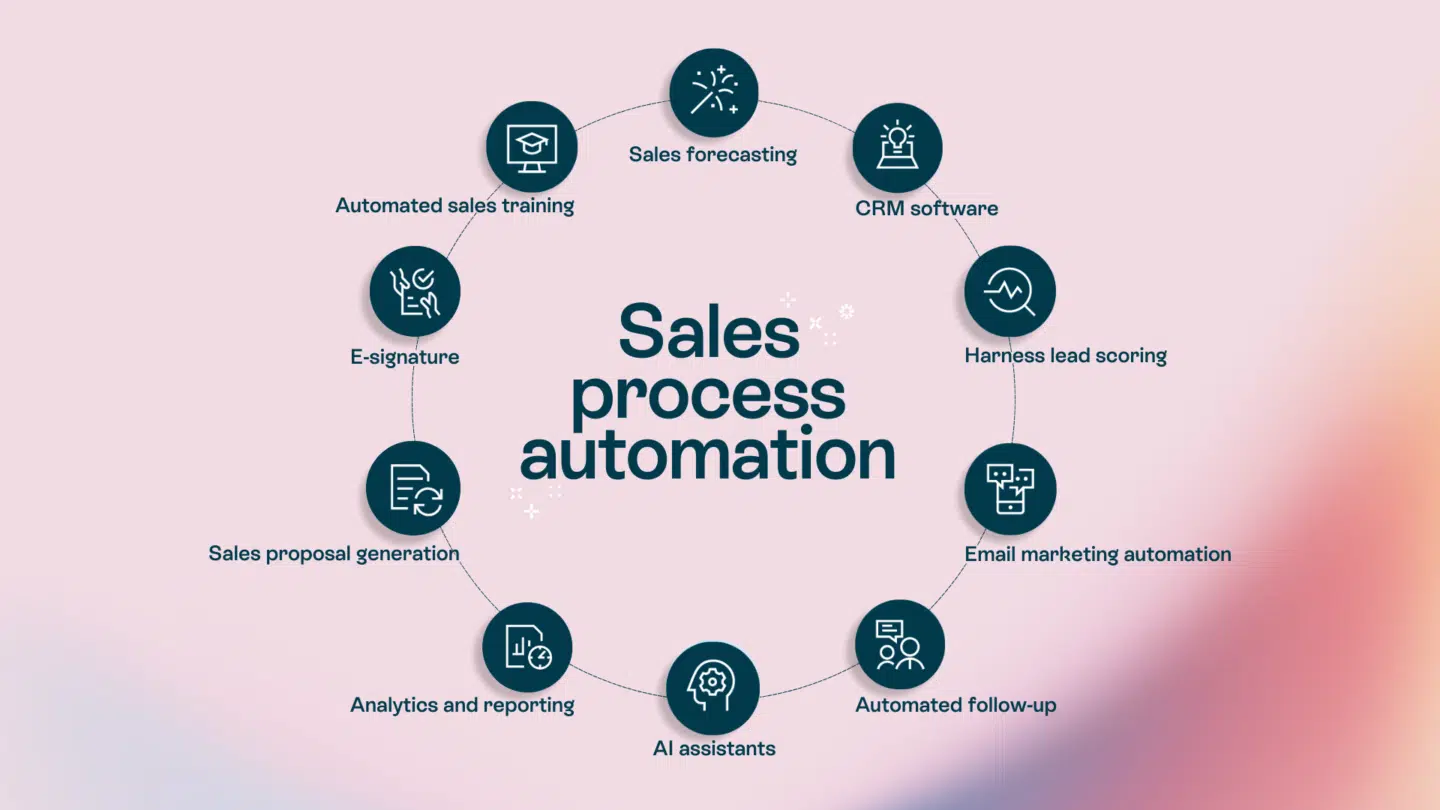
Here are 15 examples of how you can automate sales processes:
Automated Drip Email Campaigns
Automating your email campaigns can make sending targeted messages to potential customers seamless. You can leverage sales workflow automation tools to categorize your audiences based on specific criteria and trigger emails on optimal days and times. This is crucial to increase the click-to-open and conversion rates.
Using predefined templates and personalization tokens ensures that each email feels relevant to the recipient. With automated email marketing, your sales teams can communicate consistently with leads and keep them engaged without manual intervention.
Personalized Content Delivery
You can use sales automation tools to analyze customer data, including behavior and preferences, to tailor personalized messages and offers that meet their unique needs. By sending content that resonates with individual prospects, you maximize the chance of conversions, driving sales.
It is crucial to deliver value-driven content that humors your target audience’s interests and addresses their pain points at the right time. With workflow automation, you can streamline this process, building trust and establishing your organization’s credibility in the long run.
Automated Lead Generation and Nurturing
With customer relationship management systems (CRMs), you can trigger marketing campaigns and other automated processes based on potential leads’ online behavior. This includes user actions like social media interactions, email open rates, and website visits, allowing targeted outreach to individuals matching your ideal customer profile.
As leads interact with the content, the CRM tool collects data to help further personalize your communication, nurturing them through the sales funnel. It continues until they are ready for a sales conversation or opt-out.
Automated Lead Scoring and Segmentation
You can automate sales processes to segment leads based on pre-defined criteria like demographics, behavior, and engagement levels. By using pre-defined scoring models, your teams can assign points to leads based on their likelihood of buying.
For example, if a lead downloads a whitepaper or attends a webinar, their lead score increases. This can help you identify your most qualified leads and optimize your sales efforts for them. You can also send follow-ups, alerts, and other notifications to ensure you stay at the top of your potential target’s mind.
Personalized Product Recommendation
Utilizing sales automation for personalized product recommendations involves analyzing your customers’ purchase history, browsing habits, and preferences to suggest relevant products. You can utilize these automated workflows to dynamically showcase repeatedly ordered or similar products across various touchpoints, such as email, web, or mobile.
By facilitating automated product recommendations, your teams can significantly enhance customer experience and encourage repeat purchases, boosting overall sales. You can continuously refine your recommendations based on customer feedback and ensure they remain relevant and appealing.
Upselling and Cross-selling Products
You can streamline the process of upselling and cross-selling by automatically suggesting additional or complementary products based on customer data. For instance, after a customer purchases a new laptop, you can automatically send them an email recommending a compatible printer or carrying case.
Offering apt product suggestions at key stages of the customer journey increases your average order value. It also significantly improves customer satisfaction and your organization's overall business.
Meeting Scheduling
Sales workflow automation streamlines the process of scheduling meetings and appointments. You can set up automated calendar integration to check availability, suggest meeting times, and send out invitations. It eliminates the back-and-forth of emails and ensures that your meetings are scheduled promptly.
You can also prioritize meeting confirmations based on their urgency and importance. This can help your sales teams to plan and optimize their time for productive meetings.
Automated Contract Management
Automating contract management involves using tools to generate, review, and manage contracts electronically. You can create templates for common contract types and automatically populate them with relevant information based on the client’s requirements.
Additionally, you can streamline contract management by setting up automated reminders to track contract statuses. This ensures timely renewals and reduces the risk of missed opportunities or legal issues.
Generating Quotes and Proposals
Automated sales processes enable you to streamline generating quotes and proposals by instantly pulling relevant data from customer profiles, pricing tables, and product catalogs. This not only speeds up the process but also ensures accuracy and consistency.
With pre-built templates and customizable options, your sales teams can quickly deliver professional and tailored proposals, improving their chances of closing more deals. Additionally, automated workflows allow them to track the status of quotes and proposals, send reminders to follow up with prospects, and ensure timely follow-through.
Automatic Customer Onboarding
Automated onboarding processes guide your new customers through the starting stages of their journey, providing them with the necessary information, resources, and support. By automating this process, you can ensure a consistent and smooth onboarding experience and increase customer satisfaction.
Automated onboarding can also include personalized training and product usage tips, helping customers thoroughly understand and utilize the product or service. This streamlined process frees your sales and customer support teams to focus on more complex situations.
Follow-Ups and Check-Ins
Automated follow-up and check-in systems can significantly improve your sales efficiency. By setting up automated email or SMS reminders, you can ensure that no opportunities or leads slip through the cracks.
You can schedule check-in calls or emails with your existing customers for post-sale follow-ups to identify potential upselling or cross-selling opportunities. This also helps you monitor deal progress, proactively address issues, and increase close rates.
Customer Feedback and Satisfaction Surveys
Sales workflow automation can make collecting and analyzing customer feedback seamless by scheduling the deployment of surveys after a purchase or service interaction. This can lead to invaluable insights that help refine sales processes, product offerings, and customer support strategies.
Automation enables you to segment customers based on their feedback, allowing for targeted follow-ups and personalized experiences. It also allows you to identify your top-performing and under-performing sales representatives and provide them with incentives or training.
Real-Time Sales Performance Dashboards
With automated dashboards, you can gain real-time visibility into sales performance through key metrics such as lead conversion rates, sales cycle length, and revenue growth. These dashboards pull data from various sources, offering a comprehensive view of all your sales pipelines.
By leveraging this data-driven approach, you can identify trends and patterns, spot opportunities, and make informed decisions to optimize sales strategies. Real-time dashboards ensure your data is always up-to-date and allow you to facilitate quick responses to curb unexpected damages.
Sales Forecasting
Workflow automation in sales forecasting involves leveraging historical data, current pipeline information, market trends, and economic indicators to generate accurate predictions of future sales performance. This enables you to plan your organization’s inventory and allocate resources effectively.
Automated forecasting models can continuously update forecasts as new data becomes available, providing real-time insights and reducing the risk of errors in the long run.
Automated Employee Training
Sales workflow automation can make employee training and onboarding processes effortless. It involves creating on-demand training modules that help employees stay up-to-date on product knowledge, sales techniques, and company updates.
You can also track progress, provide assessments, and offer personalized learning paths based on the employee's role and knowledge level. Automation ensures that training is consistent, scalable, and easily updated as new information becomes available, allowing employees to upskill continuously.
Sales Workflow Automation Tools
Several sales workflow automation tools are available in the market. You can select the one that fits your organization’s needs, current data infrastructure, and budget. Here are some popular tools for you to explore:
Salesforce
Salesforce is a robust CRM platform offering a comprehensive tool suite for sales teams. It enables you to manage customer relationships and sales processes, improve collaboration, and boost productivity. With features like workflow automation, Salesforce empowers you to automate tasks such as lead assignment, data entry, and email campaigns.
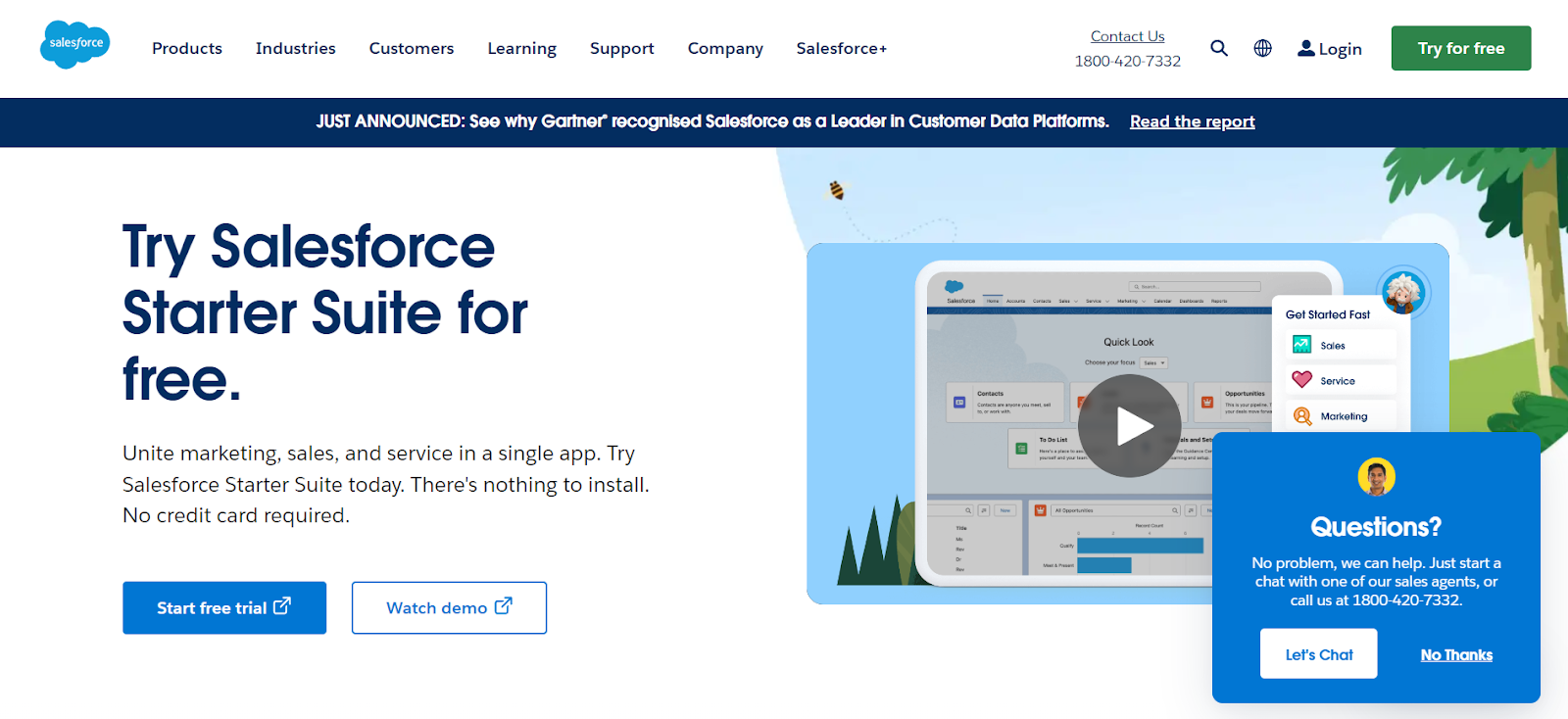
Key Features of Salesforce include:
- Flow Builder: It allows you to build automated sales processes, including approvals, data manipulation, and user interface elements, based on code-like logic without using programming languages.
- Sales Forecasting and Trend Detection: This feature provides automated, data-driven insights into your sales pipeline by leveraging historical data analysis and current market trends to predict future sales performance.
HubSpot
HubSpot is a sales and marketing platform with powerful sales automation capabilities. Its user-friendly interface and integration with other HubSpot tools make it accessible without a steep learning curve. With HubSpot, your sales teams can nurture leads, track deals, and manage customer interactions effectively.
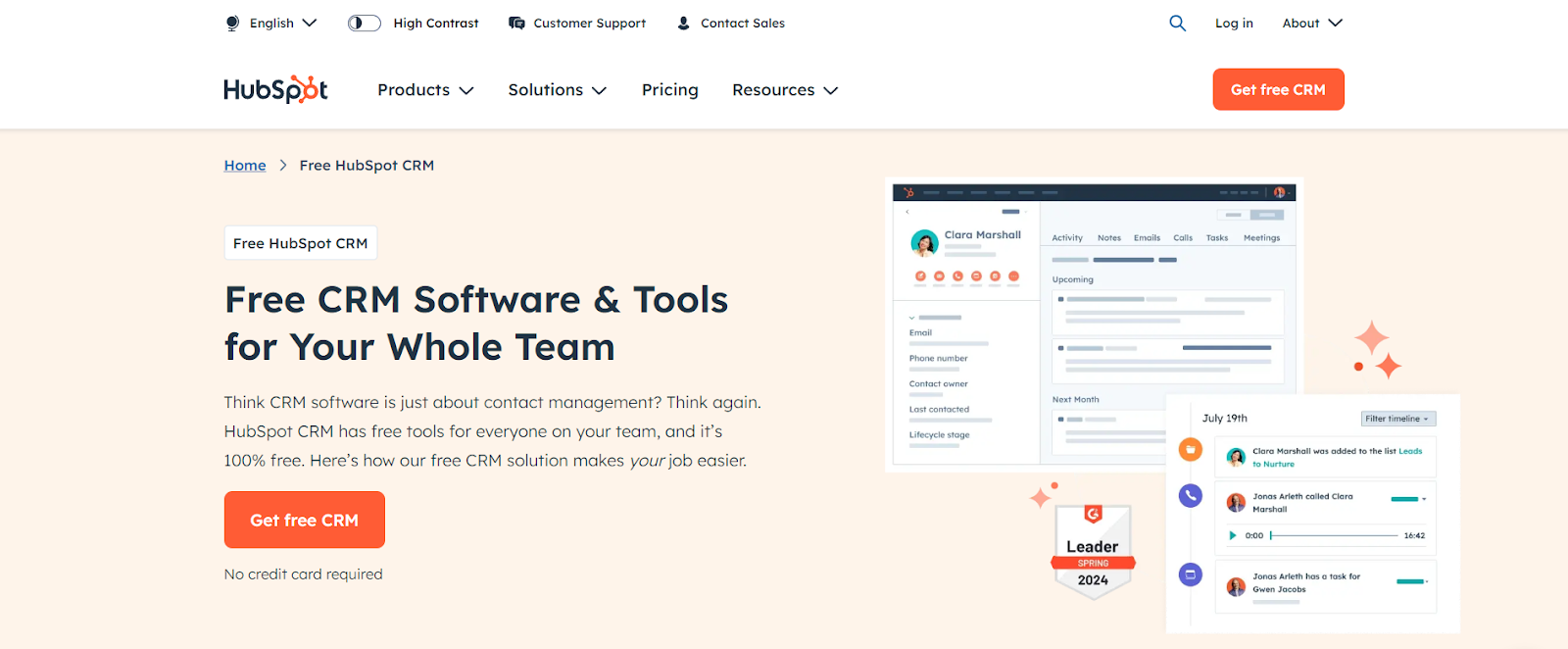
Key Features of HubSpot include:
- Automated Email Sequences: You can generate automated email and task sequences to nurture leads and engage prospects effectively. This can help improve lead conversions and shorten sales cycles.
- Prospecting: This feature empowers you to optimize your outreach strategies through rigorous testing and data analysis. By conducting A/B tests on email sequences and leveraging deal outcome reports, you can identify optimal messaging to generate sales.
Pipedrive
Pipedrive is a sales CRM focused on sales pipeline management and deal closing. With its intuitive design and visual sales pipeline, Pipedrive helps your sales teams manage leads more efficiently. It allows you to track lead progress and automate routine tasks to ensure that no deal falls through the cracks.
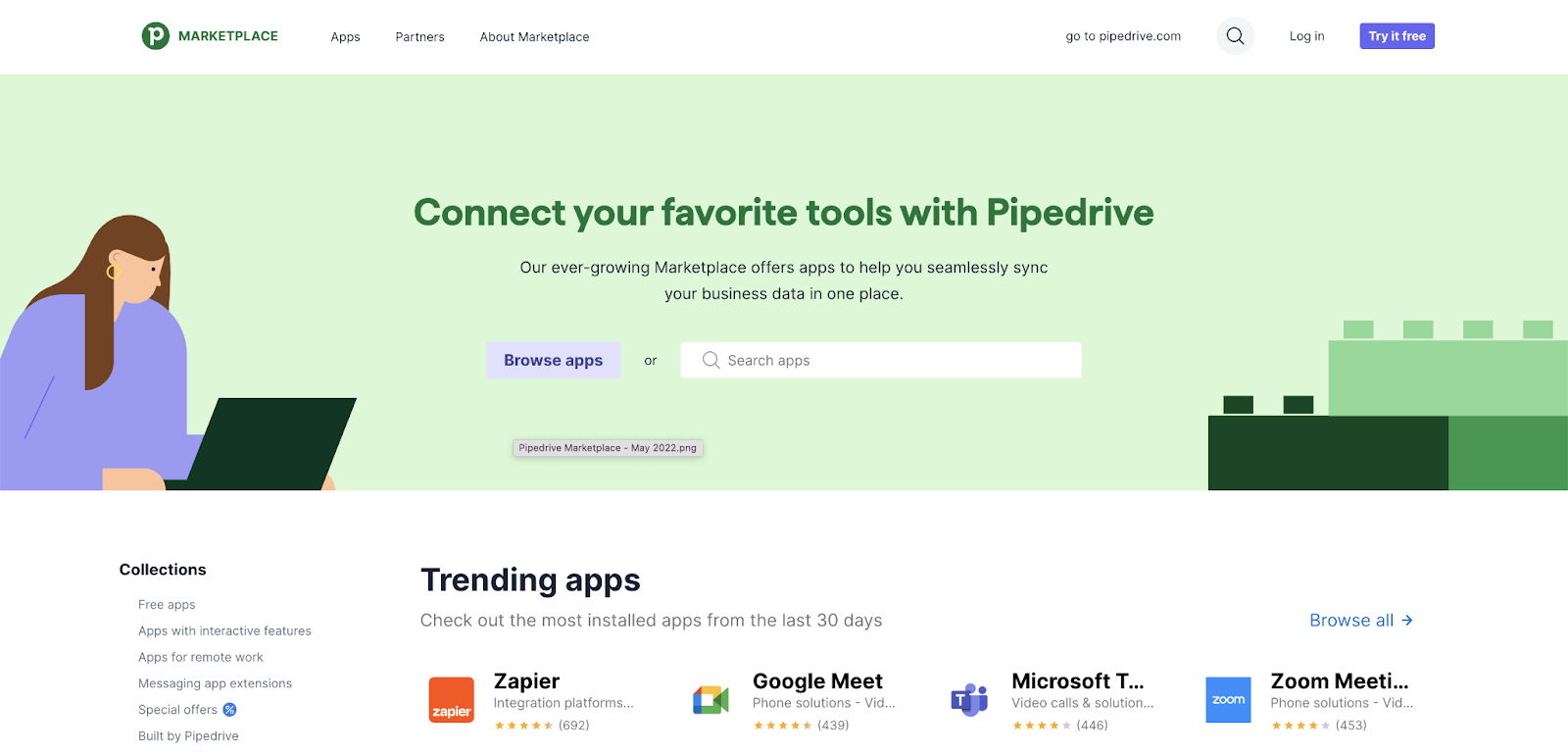
Key Features of Pipedrive include:
- Activity Reminders: Pipedrive offers activity-based reminders that are automatically generated based on the actions needed to move deals forward. These reminders inform you of the next steps you need to take to improve overall sales performance.
- Deal Stages and Automation: You can define custom deal stages within your sales pipeline and automate actions based on deal movement, ensuring consistent follow-ups and improved sales efficiency.
Outreach
Outreach, a sales engagement platform, optimizes sales outreach and improves conversion rates. While not a conventional CRM, it easily integrates with other CRMs to provide advanced features for prospecting, email campaigns, and sales acceleration. You can focus on building more substantial customer relationships by automating these time-consuming, mundane tasks.
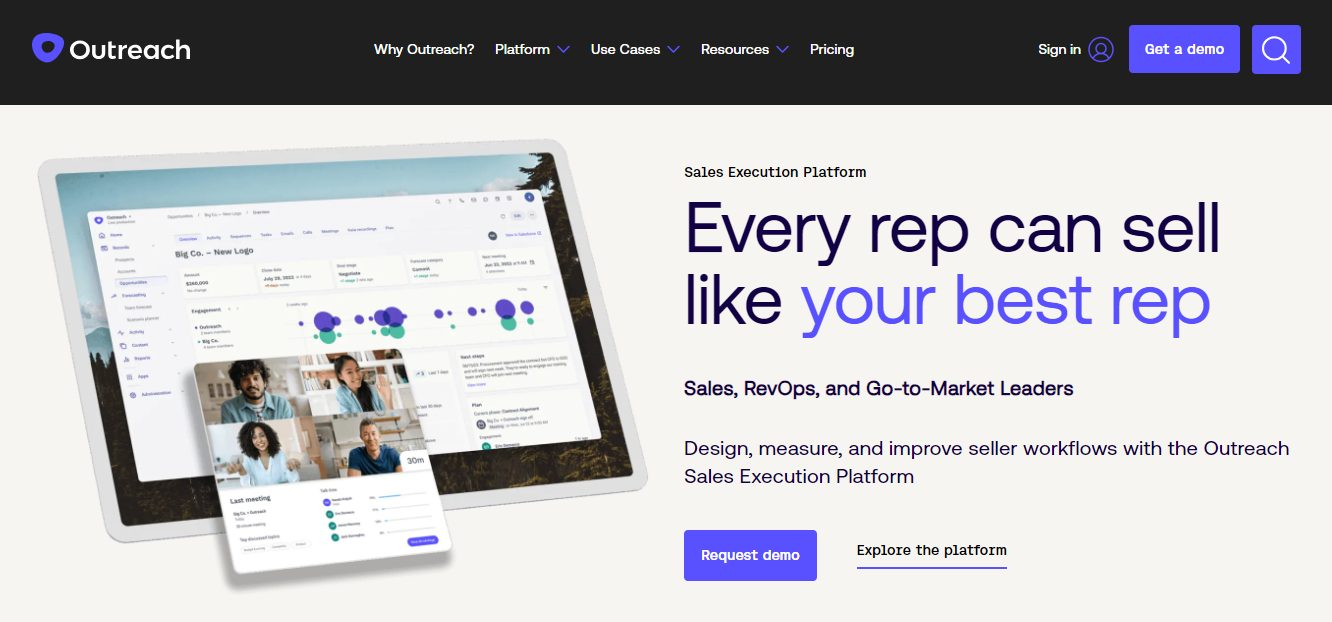
Key Features of Outreach include:
- Multi-Channel Sequences: You can create automated sequences tailored to individual prospects or segmented audiences. This includes emails, calls, and social media touches for consistent, personalized engagement across different channels.
- Sales Playbooks: They provide automated guidance on engaging with potential leads at different stages of the sales cycle, ensuring sales growth using real-time suggestions and pre-configured steps.
How to Implement Sales Workflows?
Implementing successful sales workflows requires a strategic approach and meticulous planning. Here is a breakdown of the steps involved:
Assess Your Current Sales Process
You should begin by thoroughly analyzing your existing sales process, identifying each step from lead generation to deal closure. This will help you understand your current sales funnel, identify bottlenecks, gather feedback from your sales team, and pinpoint areas for improvement and automation.
Define What You Want to Achieve
Clearly outline the high-priority objectives you want to achieve through sales workflow automation, such as reducing manual tasks, improving lead response times, or increasing conversion rates. These goals must be measurable and aligned with your sales strategy. Defining your objectives enables you to focus on the most impactful areas for automation.
Choose the Right Automation Tools
Evaluate sales automation tools based on their features, ease of integration with your current CRM, and scalability. Then, select the one that aligns with your goals, existing infrastructure, and budget. You can request free trials or demos to verify whether the tool has the potential to enhance your sales process and facilitate a smooth transition to automated workflows.
Start with One High-Impact Process
You can start small by identifying and automating one high-impact process that offers the most significant benefits, such as lead assignment or follow-up reminders. This allows your team to adapt to the new system without getting overwhelmed. By automating a vital process, you can gain stakeholders' confidence and provide a template for future automation initiatives.
Define Triggers and Actions
In this step, you determine triggers (events or conditions) that initiate your automated workflows, such as a new lead entry or deal reaching specific stages. Then, define the corresponding actions, like sending an email or assigning a task. With clear triggers and actions, you can ensure automation workflows operate smoothly and achieve the desired outcomes.
Set up and Test Your Automation
The last step involves configuring your selected automation tool based on defined triggers and actions and testing the workflows to ensure they function as intended. You can conduct tests under various scenarios to identify potential issues or adjustments. It helps prevent errors and ensures that the automation contributes to your sales process's efficiency and effectiveness.
Achieve Sales Workflow Automation with Airbyte
Effective sales automation requires seamless data movement, integration, and transformation to streamline tasks like lead scoring, customer segmentation, and personalized outreach. Airbyte, a no-code data integration platform with AI capabilities, can help facilitate these processes by consolidating data into a centralized repository.
Airbyte offers 350+ pre-built connectors, ensuring your sales team can collect accurate information from disparate sources such as CRMs, marketing automation platforms, and email providers. When loaded into your preferred destination, this unified data enables you to perform comprehensive analysis and sales forecasting.
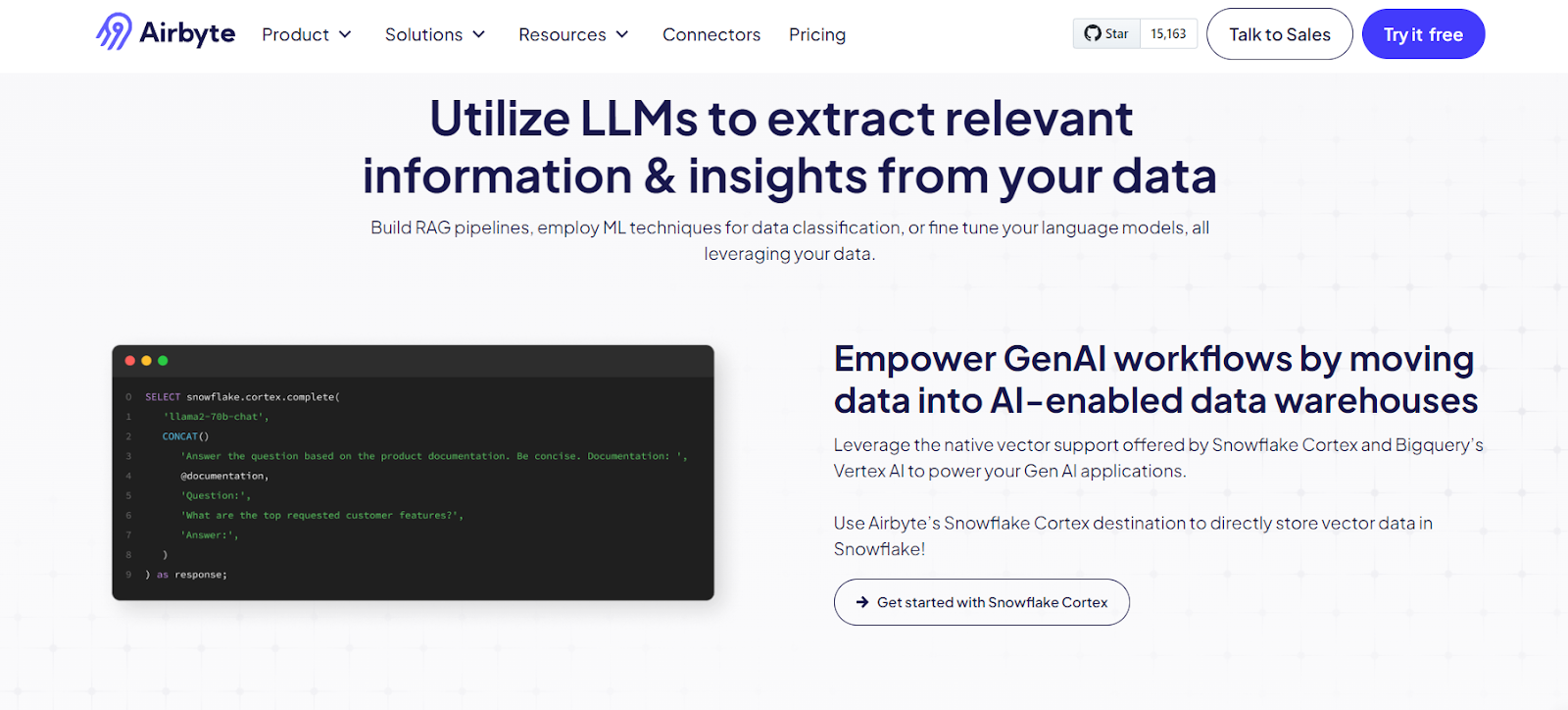
Key Airbyte features that facilitate sales workflow automation:
- Change Data Capture: Airbyte’s CDC feature enables you to capture all data changes occurring in your CRM system and incrementally reflect them in the target database. This lets your sales teams access the latest information and quickly respond to changes.
- Unstructured Data Integration: Many sales processes manage unstructured data from emails, social media, and other channels. You can leverage Airbyte-supported vector databases like Pinecone, Weaviate, and Chroma to store data after performing automatic chunking and indexing processes.
- Data Transformation: By integrating Airbyte with dbt Cloud integration, you can perform immediate transformations after data syncs. This clean, structured, and high-quality data flows into your sales automation tool and allows you to streamline your sales workflows with minimal errors.
- Build Custom Pipelines: You can use Airbyte’s Python library, PyAirbyte, to create custom data pipelines and extract data using Airbyte connectors in your Python workflows. PyAirbyte also allows you to perform complex transformations before loading your data into your target warehouse or lake, enriching it for quality data analysis.
- Scalability: Airbyte can scale to handle increasing data volumes and complexity as your organization grows. This, in turn, ensures that your sales workflow automation can adapt to changing business needs without compromising on performance.
By leveraging Airbyte's data integration capabilities, you can create a solid foundation for your sales workflow automation initiatives. To learn more about Airbyte, you can refer to the official documentation.
Key Takeaways
Sales workflow automation is essential for modern sales teams to thrive. Automating repetitive tasks lets your sales reps focus on building relationships and closing deals. This increases efficiency, improves lead quality, enhances customer experience, and improves data management.
To successfully implement sales workflow automation, you should assess your current process, define goals, and choose the right automation tool. With continuous evaluation and optimization, you can maximize its benefits and achieve sustainable growth for your organization.
FAQs
What is the difference between sales automation and CRM?
CRM focuses on managing and nurturing your customer relationships across all touchpoints, while sales automation specifically automates repetitive sales tasks to improve efficacy and productivity.
What are the disadvantages of automating sales processes?
Poorly implemented automation can result in errors and inconsistencies, damaging customers’ trust. It can also lead to impersonal interactions that fail to address individual needs and preferences.
What features or capabilities should you look for in a sales workflow automation platform?
A sales workflow automation platform should easily integrate with your existing CRM and offer robust automation capabilities for lead scoring, email sequences, and follow-up reminders. It should also have performance monitoring and reporting features for insightful decision-making.
What should you do next?
Hope you enjoyed the reading. Here are the 3 ways we can help you in your data journey:



Frequently Asked Questions
What is ETL?
ETL, an acronym for Extract, Transform, Load, is a vital data integration process. It involves extracting data from diverse sources, transforming it into a usable format, and loading it into a database, data warehouse or data lake. This process enables meaningful data analysis, enhancing business intelligence.
This can be done by building a data pipeline manually, usually a Python script (you can leverage a tool as Apache Airflow for this). This process can take more than a full week of development. Or it can be done in minutes on Airbyte in three easy steps: set it up as a source, choose a destination among 50 available off the shelf, and define which data you want to transfer and how frequently.
The most prominent ETL tools to extract data include: Airbyte, Fivetran, StitchData, Matillion, and Talend Data Integration. These ETL and ELT tools help in extracting data from various sources (APIs, databases, and more), transforming it efficiently, and loading it into a database, data warehouse or data lake, enhancing data management capabilities.
What is ELT?
ELT, standing for Extract, Load, Transform, is a modern take on the traditional ETL data integration process. In ELT, data is first extracted from various sources, loaded directly into a data warehouse, and then transformed. This approach enhances data processing speed, analytical flexibility and autonomy.
Difference between ETL and ELT?
ETL and ELT are critical data integration strategies with key differences. ETL (Extract, Transform, Load) transforms data before loading, ideal for structured data. In contrast, ELT (Extract, Load, Transform) loads data before transformation, perfect for processing large, diverse data sets in modern data warehouses. ELT is becoming the new standard as it offers a lot more flexibility and autonomy to data analysts.
